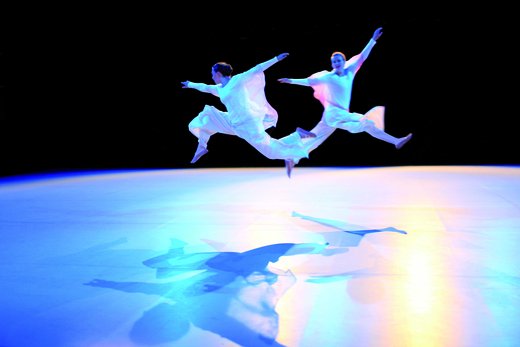Single News
Magic moments in eurythmy
The “What moves you” project brings together young people from all over the world to work on the performance in eurythmy of a major orchestral work. This year’s performance was as successful as the previous ones.
BERLIN (NNA) – At the end of the performance of “Magic Moments - What moves You” on 27 August 2016 in the Komische Oper in Berlin there was rapturous applaus and a standing ovation for the 70 young people from a total of 18 countries throughout the world, the orchestra – the Gnessin Virtuosi Moscow – and the colleagues in the artistic direction.
It was the third time that this international project under director André Macco was held. After an application and selection process, the young people came together for about four weeks in Berlin to rehearse a major orchestral work. Most of them had come into contact with, and also developed questions about eurythmy when they were at Waldorf school.
Intensive work starts from the beginning and about six hours each day are spent working with eurythmy. But this is accompanied by a programme of sightseeing and time to relax with all the other international participants. Once again the Rudolf Steiner school in Berlin Dahlem let the group use its premises.
The work is supported by a large group of individual donors and several bigger sponsors. This time it became particularly clear to me that with this initiative André Macco has started a project which could be groundbreaking in the light of the hundredth anniversary of the foundation of Waldorf education in 2019.
Because seven years in advance of that date, in 2012, the biannual “What moves you” project started to build an international network in the field of eurythmy. Furthermore, it demonstrated how this art form in particular is able to overcome boundaries of nationality and provide a counterweight to the trends which this year once again are emerging every more clearly in terrorism and fear.
It is exciting to think of the next steps which include plans for many different projects for schools as well as individual initiatives.
Concentrated and precise at all times
The highlight of the full evening’s programme was the performance of Schubert’s Symphony No. 9 in C Major. In the magazine about the performance Ulrike Wendt writes: “Franz Schubert drew on inner riches for his last symphonic work which gives continuous new life to the four almost fifteen-minute-long movements through masterly combinations of themes and motifs. The unusual instrumentation (including the repeated use of trombones in the opening movement) and the unusual part writing which often makes the orchestra sound like a choir of human voices, point a long way beyond the musical understanding of his time – in a certain sense it is already preparing the ground for the approach to composition of an Anton Bruckner or Gustav Mahler.”
The Gnessin Virtuosi, who were involved for the third time already under the direction of Mikhail Khokhlov, outstandingly met the musical challenge. The way in which the artistic directors managed to motivate and support a group of 70 to 80 young people such as to enable a feat of eurythmy of this kind comes close to a miracle. In an important step the young people themselves decided in coordination with the artistic directors who should perform in which movements and work with which “teachers” in the preparatory phase for the performance. The ideas of the young people were included in the work on the movements.
This time they dared to take the special step that the groups from the four movements repeatedly met or “visited” one another on the stage, leading to impressive group compositions on the stage. There were times when between 20 and 70 young people moved Schubert’s composition with a concentration and precision which we as the audience can only enjoy and admire.
Further dimensions
The visual impressions deepen the impression of the music by at least two dimensions – namely the movement of the individual part and the group movement which was similar to the coordinated movement of a flock of birds or school of fish, but recognisably filled here on the stage with the consciousness of the individual. The enthusiasm of the young people could be clearly felt.
A former participant, Johanna Maria Schad, wrote in the accompanying programme: “Our lecturers possessed the magic power to guide us young people to joint experiences. We explored the movement qualities of an orchestra with its different instruments and in doing so together our choreography arose. I remember impressively the caring way we treated one another before the two big performances.”
And Laura Rojas Palacio, a participant from Colombia wrote: “A different way of thinking is becoming more and more necessary for me in these times of change – and acting out of love. That is precisely what eurythmy is for me: it is magical and full of love. It is full of the wisdom that it can be a healer. And this healing impulse is what motivates me.”
The “What moves you” project has changed the world of eurythmy and the Waldorf movement and, incidentally, also led several young people to start a eurythmy training.
END/nna/cva
This report is published with kind permission of the education journal Erziehungskunst, where it appeared in the November issue.
Item: 161121-01EN Date: 21 November 2016
Copyright © 2016 Nexus News Agency CIC. All rights reserved.

